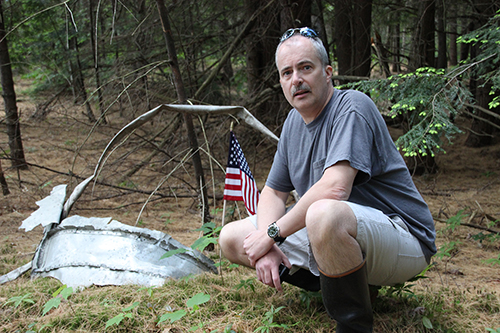
Peter Ferraro, a pilot for American Airlines, has taken as his task the planting of an American flag where military aircraft crashes result in death. “There are wrecks of military and civilian aircraft from one coast of our country to the other,” Peter says. “There are also wreck hunters, such as myself, who spend time researching and looking (sometimes with no success) for these accident sites to honor the memories of the lives that were lost at these sacred places. It’s never forgotten that these wreck sites are places where men died, and their families were left without fathers, brothers, and sons.”
Peter read online of the 1959 crash in Andover and wanted to locate and commemorate the location. He contacted Pat Cutter of the Andover Historical Society, and with the help of Bill Keyser, whose grandfather owned land in that area, Pat located the site on property now owned by Roy Sell on Switch Road.
On June 22, Pat visited the site with Peter Ferraro; Marc Goldstein, a photographer; and Roy Sell. A flag was planted and artifacts of the plane were photographed. The following is Peter’s account of the crash and his efforts to memorialize the site.
In the early morning hours of July 22, 1959, a US Air Force Boeing KC-97G Stratotanker, serial number 52-2703, crashed in East Andover. All seven crew members aboard died in the accident.
The aircraft, call sign Cutoff 17, was part of the 509th Air Refueling Squadron based at Pease Air Force Base in Newington. The crew of Cutoff 17 was tasked that evening to take part in a Strategic Air Command (SAC) reflex action refueling mission. SAC regularly deployed state-side based bombers to overseas bases to stand nuclear alert during the Cold War. These reflex action missions required coordinating multiple air-to-air refuelings en route, as the bombers would normally fly to their destinations non-stop.
Cutoff 17’s mission that night would take them on a refueling track across New Hampshire and into Maine, ending over Princeton near the border of New Brunswick, Canada. After completing their refueling commitment, the crew was to fly to Olmstead Air Force Base in Pennsylvania (now Harrisburg International Airport), where the aircraft was to undergo maintenance modification work.
Due to scheduling changes from SAC, the crew was sent home for crew rest after reporting to the base on the morning of July 21. They then reported back to Pease at 9:45 that evening. The 509th was supposed to provide three KC-97s for that night’s mission, but one aircraft was unavailable due to maintenance reasons, so Cutoff 17 was moved up from number two to the lead tanker position.
Preflight and mission briefing were normal, and after engine start, Cutoff 17 departed Pease at 12:33 AM on July 22, followed a few minutes later by the second KC-97 in the flight, Cutoff 15.
Cutoff 17 departed to the northwest. The aircraft’s flight plan took it over Concord, where it turned southwest and proceeded to Keene. From there, the crew flew north, passing over their next navigation checkpoint of Lebanon. They then turned east to proceed to the refueling orbit point.
Both aircraft had departed in low visibility conditions, but by the time the two tankers reached the orbit point, Cutoff 17 had slow climbed to 15,000 feet. Both aircraft were now in clear conditions.
At 1:43 AM, Cutoff 15 was a thousand feet below Cutoff 17 and approximately seven miles away. The crew of Cutoff 15 observed Cutoff 17’s radar beacon stop transmitting and then a fire develop in the wing area of Cutoff 17. The fire grew in intensity very fast, and Cutoff 17 entered a spiral and then went out of control. It was last seen by the in-flight refueling boom operator of Cutoff 15 engulfed in flames and in a spin. The aircraft entered the undercast, and then a bright explosion lit the clouds.
Killed in the crash was Crew T-82: Aircraft Commander Captain James White, Copilot 1/Lt Dean Holzworth, Navigator 1/Lt Harold High, Flight Engineer TSGT Owen Combs, Boom Operator TSGT Jake Schmidt, Scanner TSGT Marion Ackermand, Scanner A/3C Phillip Darst.
Ironically, the regular copilot on the crew was on leave and was replaced that night by 1/Lt Holzworth. All of the crew, with the exception of Airman Darst, were married.
I received a copy of the accident report from the Air Force accident records center at Kirtland Air Force Base in Albuquerque, which is very detailed as to the flight and cause of the accident. The Air Force Accident Investigation Board determined after a thorough investigation that the cause of the crash was due to a loss of lubrication to the bearings in the #4 engine turbo supercharger. That led to a failure of the turbo supercharger shaft.
The turbine, once unloaded, accelerated to destruction and caused the uncontained catastrophic fire, due to what would presumably have been severed fuel lines or punctured tanks in the wing.
The aircraft impacted the ground in essentially a flat spin. There was evidence that some of the crew members attempted to put on their parachutes and escape, but due to the lateral G-force, it was an almost impossible task.
I came across a reference to this crash in the Air Safety Network online database and was determined to find the final resting place of this aircraft because of the New Hampshire connection. I owe many thanks to Pat Cutter, President of the Andover Historical Society. She was very helpful in putting me in touch with the property owner where the aircraft came down. Thanks also to Roy Sell, who allowed me to access the site on his land.
We left a flag at the site to honor the memory of the men who died that night almost 55 years ago serving our country. You are not forgotten.